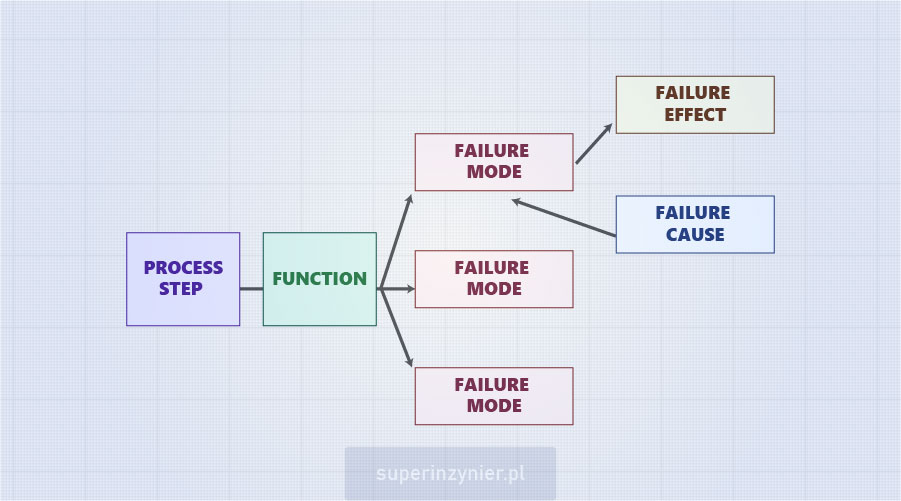P-FMEA concept
When preparing the production process for a product or group of products, we aim to optimize the process for efficiency and minimize the occurrence of defects. During the process, when quality problems arise, we take measures to improve the process. After a certain period of time, we succeed in identifying most problems, thus achieving process stability and high product quality.
However, it should be emphasized that such a method of work is costly, because at the beginning of the production process there are often a lot of defects, and only after it is refined the number of defects decreases. In addition, this approach can negatively affect our business relationships, which is not advisable. In practice, it is more like a "trial-and-error" or "battle reconnaissance" approach, which carries unnecessary costs.
However, there is a method that can predict most of the potential product defects and their causes in the production process, and then reduce these problems to a minimum before the start of mass production. We are talking about the P-FMEA (Process Failure Mode and Effects Analysis).
In this method, the production process is broken down into smaller, more manageable "process steps" for which a P-FMEA analysis is performed.
Does it work?
The correct application of P-FMEA facilitates the implementation of the product into production, thereby increasing the company's chances of success. With P-FMEA, we can detect significant risks and reduce them before serial production begins. We can reduce rework, scrap and improve productivity, ultimately reducing costs.
The key aspect is "correct application" - that is, if we conduct the analysis at the right time (very important), with the right approach (also very important), do it "for us" and not "for the customer/auditor," then we will get a kind of overview of the process with specific failure modes, potential causes and some ideas for process improvement. If we implement meaningful risk reduction actions, we will reduce potential losses.
Meaningful actions are technical solutions that reduce the occurrence of causes or detect causes or defects. Examples of actions include: eliminating unnecessary activities (e.g., transports), automating processes, error-proofing/mistake-proofing, enhancing process capabilities, and improving technical detection methods.
Actions that make little sense are: increasing the frequency of inspections, additional inspection, further training of an already repeatedly trained operator ;) and other ideas to "increase operator vigilance"..
For whom is P-FMEA?
P-FMEA is an ideal tool for those who are responsible for implementing a product into production.
When start the P-FMEA?
We launch P-FMEA as early as possible, preferably at the initial stage of product implementation in production before ordering tools or specific machines.
Management responsibility
Management commitment is critical to the success of the P-FMEA at the plant. Management should provide resources and determine who is responsible for overseeing the P-FMEA, overseeing the implementation of improvement activities, etc. This responsibility should not be shifted to the quality department or external consultants.
Main steps of P-FMEA
Depending on the standard used, there are some differences in the implementation of the P-FMEA, but typically we can identify the following major steps in the analysis:
- Determine the P-FMEA team.
- Define the scope of analysis.
- Identification of process steps.
- Determine functions and requirements (known as function analysis).
- Identification of failure modes, effects and causes (known as failure analysis).
- Determine prevention and detection methods, indicators: S, O, D, RPN/AP (so-called risk analysis).
- Determine risk reduction actions and implement them.
- Risk reassessment (after implementation of actions)
- Identify special characteristics and agree correct control.
- Develop a Control Plan (with linkages to the P-FMEA).
- Sometimes, the P-FMEA is updated due to the changes in process, various improvements, etc.
- Update P-FMEA during 8D or Global 8D problem solving process.
The following example is part of the analysis, where the relationship between the process step - function - failure mode - effect(s) and cause(s) is captured.

P-FMEA standards
There are many standards related to P-FMEA. Below are some of them:
- AIAG FMEA
- VDA FMEA
- AIAG-VDA FMEA
- SAE J1739
- Specific methods of some vehicle manufacturers (OEMs): Ford, PSA, Renault, etc.
- AS-13004 (aviation).
- Others.
If we have the option of choosing a standard, I personally prefer AIAG FMEA-4 (although it is an older version) or the very well-developed SAE J1739:2021 (the latest edition, related to AIAG-VDA FMEA). These methods can be implemented quite easily without the need to purchase specialized software, and if implemented correctly can produce excellent results.
It is also possible to use the AIAG-VDA FMEA method, which is now (in 2023) required by most automotive OEMs. However, for more complex processes, it can be difficult to apply it effectively in a spreadsheet. In such cases, specialized software should be considered.
AIAG-VDA FMEA also has some subtleties that can affect less effective results.., but that's a topic for another article ;)
Feel free to read a short article: History of FMEA.
Summary
P-FMEA is a great method for predicting potential losses in the production process before they occur. When used properly, the analysis reduces potential costs and increases the chances of success for a given project. P-FMEA is an excellent method for predicting potential losses in a production process before they occur. Properly applied, the analysis reduces potential costs and increases the chances of success for a given project. Therefore, the proper application of P-FMEA has to be a highly important aspect for company management.




